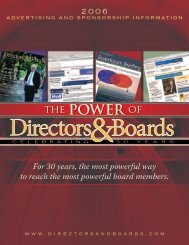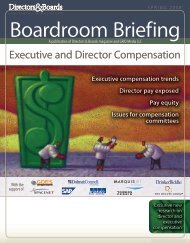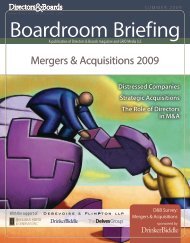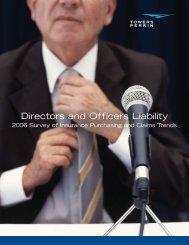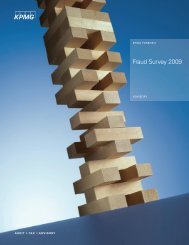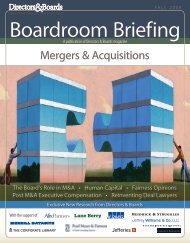The LRN ethics and compliance risk management practices report
The LRN ethics and compliance risk management practices report
The LRN ethics and compliance risk management practices report
You also want an ePaper? Increase the reach of your titles
YUMPU automatically turns print PDFs into web optimized ePapers that Google loves.
TRENDS<br />
ondents man<br />
900%<br />
000%<br />
Respondents<br />
2007 2900%<br />
2008 4000%<br />
ondents r Reporting<br />
400%<br />
Respondents<br />
700% 2007 2400%<br />
2008 1700%<br />
2007 2008<br />
000%<br />
hallenges<br />
6400%<br />
2007 2008<br />
500% etaliation 5400% 5000% 6400%<br />
500% otivated 4600% 3500% 5400%<br />
allenges 900% 4200% 4500% 4600%<br />
300% s 3300% 2900% 4200%<br />
anagement 700% 2800% 1300% 3300%<br />
underst<strong>and</strong>1900%<br />
1700% 2800%<br />
o 200% respond 1300% 900% 1900%<br />
2200% 1300%<br />
52%<br />
2007<br />
Increased use of internal ombudsman – Compared to 2007, more companies indicated<br />
having an internal ombudsman – responsible for investigating <strong>and</strong> resolving issues – as a<br />
potential channel for <strong>report</strong>ing violations, 40% in ‘08 vs. 29% in ‘07.<br />
Internal Ombudsman<br />
Internal Ombudsman<br />
100%<br />
58%<br />
52%<br />
2008 2007<br />
80%<br />
60%<br />
40%<br />
58%<br />
20%<br />
0%<br />
100%<br />
80%<br />
60%<br />
40%<br />
20%<br />
0%<br />
2008 % Respondents<br />
% Respondents<br />
No Set Policies for Reporting<br />
No Set Policies for Reporting<br />
24%<br />
17%<br />
10%<br />
17%<br />
0%<br />
0%<br />
2007<br />
2008 2007 % Respondents<br />
2008<br />
% Respond<br />
More Companies having set policies for <strong>report</strong>ing violations – Compared to 2007, the<br />
percentage of respondents indicating that their company has no set policies for <strong>report</strong>ing<br />
decreased by 60%. In 2007, nearly one-quarter of respondents had no set policy for<br />
<strong>report</strong>ing violations, whereas in 2008, only 17% responded having no <strong>report</strong>ing policy.<br />
24%<br />
50%<br />
40%<br />
30%<br />
20%<br />
50%<br />
40%<br />
30%<br />
20%<br />
10%<br />
Top Detection Challenges<br />
Top Detection Challenges % Respondents<br />
% Respondents<br />
0% 20% 40% 60% 80% 100%<br />
0% 20% 40% 60% 80% 100%<br />
50%<br />
aliation<br />
50%<br />
mployees fear retaliation 64%<br />
64%<br />
35%<br />
otivated<br />
mployees not motivated 54%<br />
45%<br />
allenges<br />
No significant challenges 46%<br />
29%<br />
ate uses<br />
Inappropriate 42% uses<br />
13%<br />
agement<br />
ck of formal <strong>management</strong><br />
33%<br />
17%<br />
derst<strong>and</strong><br />
ployees don't underst<strong>and</strong><br />
28%<br />
9%<br />
respond<br />
nsufficient staff to 19% respond<br />
Other<br />
22%<br />
13%<br />
2007<br />
2008<br />
Other<br />
35%<br />
54%<br />
45%<br />
46%<br />
29%<br />
42%<br />
13%<br />
33%<br />
17%<br />
28%<br />
9%<br />
19%<br />
22%<br />
13%<br />
2007<br />
2008<br />
Evaluating Risks<br />
Amendments to the US Federal Sentencing Guidelines call for organizations to “take<br />
reasonable steps to evaluate periodically the effectiveness of the organization’s <strong>compliance</strong><br />
<strong>and</strong> <strong>ethics</strong> program,” including oversight by “high-level personnel.” 2 Similarly, Sarbanes-<br />
Oxley Section 404 requires <strong>management</strong> to take responsibility for <strong>and</strong> assess the<br />
effectiveness of internal controls <strong>and</strong> procedures. Several trends in how companies evaluate<br />
their <strong>ethics</strong> <strong>and</strong> <strong>compliance</strong> programs point to weakening capabilities among companies<br />
Formal Culture Assessment<br />
to benefit from measuring their program effectiveness <strong>and</strong> using the results to create<br />
Year<br />
%Respondents<br />
2007 2500%<br />
improvements. While some 2008 survey findings are positive, several key evaluation <strong>practices</strong><br />
2008 3500%<br />
are declining when compared to 2007.<br />
Top Challenges in Evaluating in Ethics <strong>and</strong> Compliance Program 2007 2008<br />
More companies<br />
Correlating results<br />
using<br />
to business<br />
a<br />
improvements<br />
formal cultural assessment<br />
3300%<br />
–<br />
2500%<br />
A significant increase occurred<br />
Correlating data to results 3900% 2400%<br />
in the number Aggregating of <strong>and</strong> companies analyzing data using a formal cultural assessment: 2900% 2300% 35% of respondents in 2008<br />
Collecting data programs conducted at international regions 2200% 1400%<br />
vs. only 25% of respondents in 2007. <strong>The</strong> more common use of formal cultural assessments<br />
demonstrates that companies recognize the need to build awareness <strong>and</strong> create a value-based<br />
culture rather than basing their programs simply on ensuring <strong>compliance</strong> with regulations.<br />
Formal Culture Assessment<br />
50%<br />
40%<br />
Correlating results<br />
business improveme<br />
35%<br />
30%<br />
Correlating data to resu<br />
25%<br />
20%<br />
2007<br />
2008<br />
10%<br />
0%<br />
% Respondents<br />
Aggregating a<br />
analyzing d<br />
Collecting data<br />
programs conduc<br />
at international regio<br />
<strong>LRN</strong> | 2008 Ethics <strong>and</strong> Compliance Risk Management Practices Report | 15



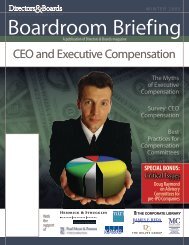
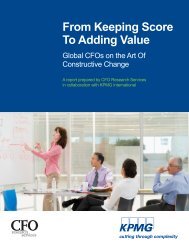
![[link to PDF] for a copy of the briefing paper - Directors & Boards](https://img.yumpu.com/43729022/1/190x245/link-to-pdf-for-a-copy-of-the-briefing-paper-directors-boards.jpg?quality=85)
